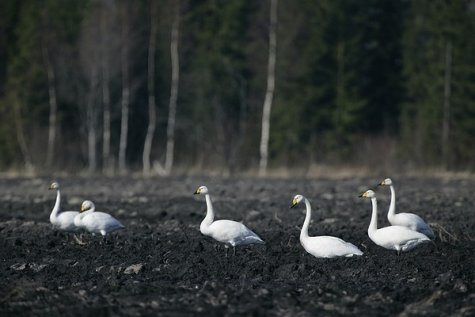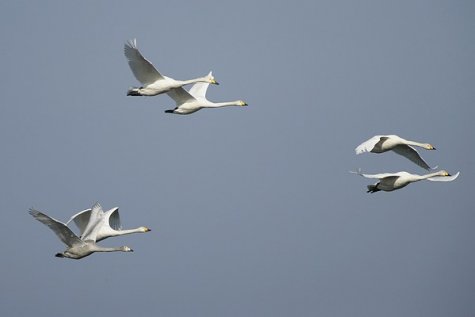Large proud white birds
Photos: Arne Ader
Translation: Liis
Whooper swans
Whooper swan Laululuik Cygnus cygnus
The number of whooper swans passing on migration in early spring is estimated at more than 15 000 birds, in addition there many were also wintering in our coastal waters this year.
The national bird of Finland is breeding in gradually increasing numbers in Estonia and this year up to a hundred whooper swan pairs may nest here.
Mute swans are quite familiar birds to us, their neck is gracefully arched on swimming, the red beak, with a bump, is turned downwards and the wings are often raised as ”sails”.
The black beak tip and yellow beak stem of the whooper swan smoothly proceed in a wedge shape to the forehead of the bird. The neck is held straight and the wings are nicely on the back on swimming. On a whooper swan reaching for food from the bottom of a water body the short and rounded tail catches the eye, and the tail tip looks as if cut off.
The measures of the large white swans are rather similar – length around a meter and a half. The wingspan is a little less than two and a half metres; the weight varies quite strongly depending on age, ranging between 7 and 12 kilos. The young birds of last year still have a grey plumage.
The trumpet-like calls of whooper swans are mighty. From a migrating flock noises like ”dogs yelping” can be heard. Calls from mute swans are seldom heard.
Most of us have surely heard the characteristic swishing from the wings of mute swans flying overhead; from migrating whooper swan flocks we won’t hear this sound.
Good observation places for whooper swans are the Haapsalu bay, Matsalu gulf and the coastal area at Häädemeeste, but we also meet passing migrants at lakes and polders.
Whooper swan observations: LINK
As comparison mute swan observations, and it can be added that more than 3 000 pairs nest in Estonia: LINK
Whooper swans










